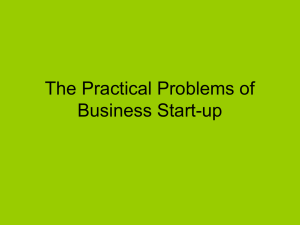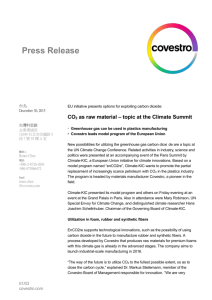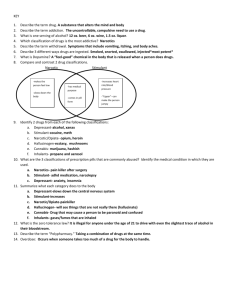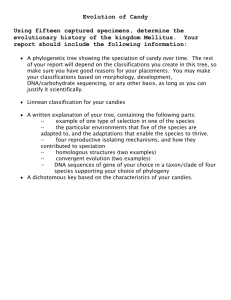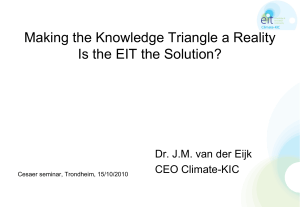Definitions, classifications and data banks of green technology start
advertisement
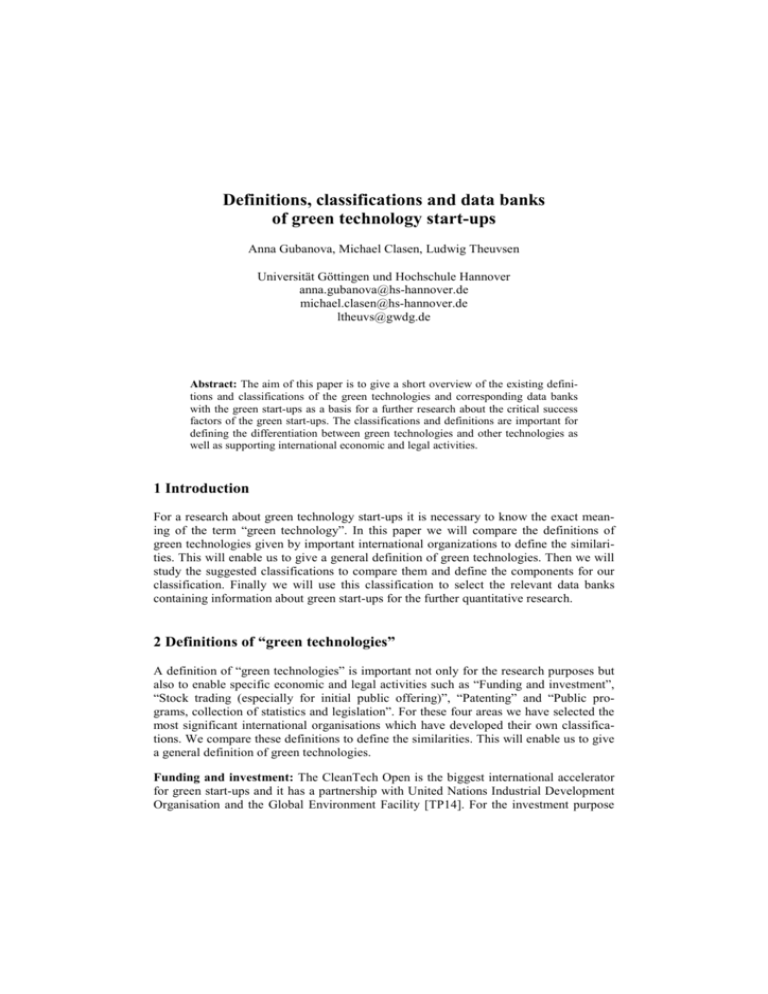
Definitions, classifications and data banks of green technology start-ups Anna Gubanova, Michael Clasen, Ludwig Theuvsen Universität Göttingen und Hochschule Hannover anna.gubanova@hs-hannover.de michael.clasen@hs-hannover.de ltheuvs@gwdg.de Abstract: The aim of this paper is to give a short overview of the existing definitions and classifications of the green technologies and corresponding data banks with the green start-ups as a basis for a further research about the critical success factors of the green start-ups. The classifications and definitions are important for defining the differentiation between green technologies and other technologies as well as supporting international economic and legal activities. 1 Introduction For a research about green technology start-ups it is necessary to know the exact meaning of the term “green technology”. In this paper we will compare the definitions of green technologies given by important international organizations to define the similarities. This will enable us to give a general definition of green technologies. Then we will study the suggested classifications to compare them and define the components for our classification. Finally we will use this classification to select the relevant data banks containing information about green start-ups for the further quantitative research. 2 Definitions of “green technologies” A definition of “green technologies” is important not only for the research purposes but also to enable specific economic and legal activities such as “Funding and investment”, “Stock trading (especially for initial public offering)”, “Patenting” and “Public programs, collection of statistics and legislation”. For these four areas we have selected the most significant international organisations which have developed their own classifications. We compare these definitions to define the similarities. This will enable us to give a general definition of green technologies. Funding and investment: The CleanTech Open is the biggest international accelerator for green start-ups and it has a partnership with United Nations Industrial Development Organisation and the Global Environment Facility [TP14]. For the investment purpose the clean tech was defined “as any product, service, or technology that uses natural resources more efficiently, interacts with the environment in a more closed-loop, sustainable way and is intended to be commercially viable and scalable” [CTO14]. Trade: CleanTech Index has been launched by CleanTech Group and was a pioneering index on the stock market for green tech companies. According to the CleanTech Group the clean technologies represent “knowledge-based products and services that add economic value by reducing cost, raising productivity and/or product performance while reducing resource consumption and their negative impact on the environment and public health” [CTG09, p.2]. Patenting: In 2009 the World Intellectual Property Organisation (WIPO) presented an international patent classification “Green Inventory” [WIPO14]. This classification should help to collect the data on the environmentally sound technologies in order to facilitate the search for patent information. The definition of the environmentally sound technologies was offered by the United Nations in 1997 as “techniques and technologies capable of reducing environmental damage through processes and materials that generate fewer potentially damaging substances, recover such substances from emissions prior to discharge, or utilize and recycle production residues” [UN97, p.30]. Public programs and collection of statistics: In 1999 the Organisation for Economic Co-Operation and Development (OECD) together with the Eurostat group introduced the classification and definition of the environmental goods and services. The environmental goods and services were identified as „activities which produce goods and services to measure, prevent, limit, minimise or correct environmental damage to water, air and soil, as well as problems related to waste, noise and eco-systems” [OECD99, p.9]. The environment goods and services also include cleaner technologies which are “products and services that reduce environmental risk and minimise pollution and resource use” [OECD99, p.9]. Our definition as intersection: All four definitions are referring to the two main purposes of the green technologies: 1) reducing or minimizing environmental damage or risk, 2) more efficient resource use (recyclable, sustainable). So in our definition a green start-up is a start-up whose business model follows at least one of these two purposes. 3 Classifications and data banks of green start-ups This definition will be used as a guideline for the development of our classification for the green technologies, which is also based on the existing classifications of CleanTech Open, CleanTech Index, WIPO and OECD. Figure 1 shows the sub-categories of the four classifications. Waste management, Renewable energy, Energy storage and distribution and Agriculture are contained in all four existing classifications. But on basis of our definition we add another four categories (italics). So we will classify green technology start-ups as follows: 1. 2. 3. 4. 5. 6. 7. 8. Forestry/Agriculture: include innovative, efficient and eco-friendly forestry/farming technologies that reduce resources to produce food, improve supply chain and ensure sustainable food security. Energy efficiency: Energy efficiency technologies enable to save energy in storage, distribution and usage Water and waste management: include technologies which are eco-friendly and efficient in the collecting, purification, conservation, recycling/reusing water and waste. Renewable energy: technologies that enable the usage of renewable energy and alternative sources of energy biomass, waste heat etc. Transportation: technologies which include energy-efficient and less-polluting vehicles of all types and related components. Green Building: technologies enable to reduce the environmental damage from construction by using innovative, energy- and material efficient building materials as well as innovative design. Eco-tourism: technologies that enable “responsible travel to natural areas that conserves the environment and improves the well-being of local people” [TIES90]. Environmental quality/safety: technologies which enable monitoring, analysis and control the environmental risks and damage. Figure 1: International classifications of green technologies Table 1 below shows data banks containing start-ups in the eight identified categories. The numbers in brackets are showing the number of the green start-ups in these categories in each data bank. Agriculture/Forestry www.climate-kic.org (5) www.angel.co (511) www.vilcap.com (40) www.energyexcelerator. com (3) www.f6s.com (524) Transportation www.climate-kic.org (7) www.angel.co (124) www.f6s.com (53) www.ecosummit.com (5) www.energyexcelerator. com (4) www.vilcap.com (4) Energy storage/ distribution/ efficiency Water / waste management www.climate-kic.org (21) www.energyexcelerator. com (13) www.angel.co (226) www.f6s.com (262) www.ecosummit.com (23) www.vilcap.com (4) www.climate-kic.org (10) www.f6s.com (95) www.vilcap.com (9) www.angel.co (189) www.energyexcelerator. com (1) www.ecosummit.com (3) Green building Eco-Tourism www.angel.co (100) www.vilcap.com (3) www.climate-kic.org (4) www.energyexcelerator. com (1) www.climate-kic.org (1) www.f6s.com (18) Renewable energy www.climate-kic.org (12) www.bethnalgreenventur es.com (1) www.energyexcelerator. com (2) www.angel.co (180) www.f6s.com (200) www.ecosummit.com (7) www.rockstart.com/(2) www.vilcap.com (5) Environmental quality / safety www.climate-kic.org (6) www.vilcap.com (2) www.angel.co (165) www.rockstart.com/(4) www.energyexcelerator. com (1) Table 1: Start-up data banks for selected green technologies In this paper we have defined green technologies and its classification based on the international classifications and definitions. With this definition we are able to decide if a start-up is a “green”-start-up or not. 4 Literature [CTO14] CleanTech Open: online platform-accelerator for cleantech start-ups http://www2.cleantechopen.org/ Last visit: 20.10.2014 [OECD99] Organisation for Economic Co-Operation and Development (1999): The environmental goods and services industry. Manual for data collection and analysis, Paris, pp. 9-13, http://unstats.un.org/unsd/envaccounting/ceea/archive/EPEA/ EnvIndustry_Manual_for_data_collection.PDF Last visit 20.10.2014 [TIES90] The International Ecotourism Society (1990): Definition of ecotourism https://www.ecotourism.org/what-is-ecotourism Last visit 20.10.2014 [UN97] United Nations (1997): Glossary of Environment Statistics, Studies in Methods, Series F, No. 67, New York, http://unstats.un.org/unsd/publication/SeriesF/SeriesF_67E.pdf Last visit 20.10.2014 [WIPO14] World Intellectual Property Organisation: IPC Green Inventory http://www.wipo.int/classifications/ipc/en/est/ Last visit: 20.10.2014
